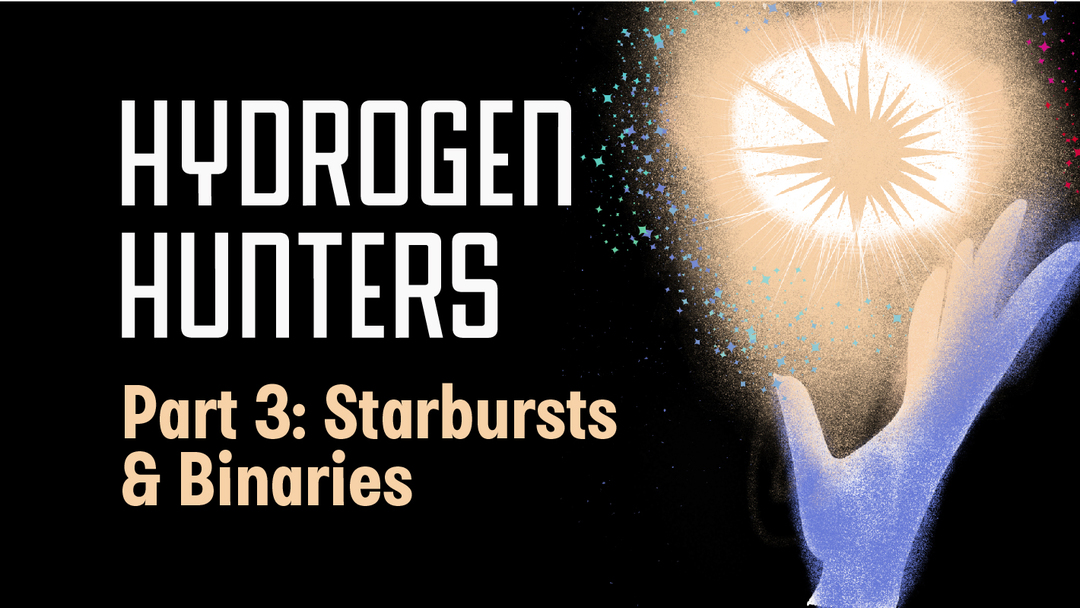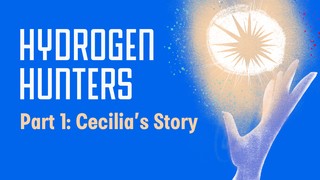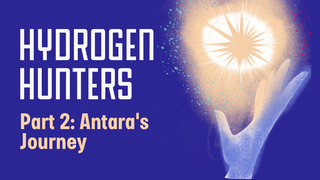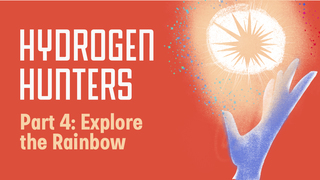
Download Episode (21.9 MB) Download Low Music/Distraction Episode (21.9 MB)
Feedback for Hydrogen Hunters Part 3: Starbursts and Binaries
By leaving feedback, you agree to allow NASA's Universe of Learning to publish the content and information you provide in your submission form. We will only use this information to recognize your entry on our series and social media, and we will never publish your email.Transcript for Hydrogen Hunters Part 3: Starbursts and Binaries
Hello everyone, and welcome back to NASA’s Universe of Learning’s Diaries of the Cosmos. I’m Rutuparna Das, and today on Hydrogen Hunters, we’re continuing our chat with Dr. Antara Basu-Zych, a NASA astrophysicist at the University of Maryland. Last time, we heard about Antara’s early experiences with science and her path to where she is today. Now, we’re going to dive deeper into how she explores the universe by looking at hydrogen.
Continuing our chat with Antara is Elizabeth Gutierrez, who, as an intern with the Smithsonian American Women’s History Initiative, researched and developed much of our Hydrogen Hunters story. Over to Elizabeth!
Elizabeth: Thanks Rutu! Hello again everyone! I’m Elizabeth Gutierrez, back here to continue our conversation with Dr. Antara Basu-Zych. So, Antara, I want to hear more about your science! Cecilia Payne-Gaposchkin used hydrogen to study stars and our universe and find out that they're mostly made out of hydrogen and helium, and I've heard that you use hydrogen in your work – could you maybe please tell us more about that?
Antara: Sure! So my interest is in studying starburst galaxies, which are galaxies that have recently turned on their star formation – they've become very active in forming stars. And so, hydrogen, you know, from what Cecilia had discovered, is really the most abundant element in the universe. So I'm interested in both how hydrogen acts as a fuel, because this is what is being turned into new stars, but also how the stars then interact with the surrounding hydrogen once they're, you know, once they’ve become stars, so both of those are interesting to me. And the hottest and most massive stars are very short-lived – so these are the ones that kind of party hard and die early. Um, and they produce the largest quantities of photons – or light particles – and so, these are the photons that are able to interact with the surrounding hydrogen gas. So the way a star forms is there's this birth cloud, and it's hydrogen gas, and it collapses, and eventually when the star is formed, it is, it's still in that birth cloud, and it produces so much of the light – of the photons. They're high enough energy that they're able to, um, cause the hydrogen gas to start glowing. And so, um, you see, most all elements have a very specific fingerprint.
Rutu [interjection]: A specific elemental fingerprint – this is the set of spectral lines we talked about in Part 1, the same elemental fingerprints Cecilia used to figure out what the stars are made of. We’ll talk more about how to do spectroscopy in future stories, but right now, let’s follow Antara as she uses Hydrogen spectra to explore galaxies and star formation.
Antara: So if you take the spectrum of glowing gas clouds, like this hydrogen gas cloud, you know exactly, um, what elements, you know, are in that gas cloud. And so the hydrogen regions around young stars can glow very bright, and we can actually use this glowing gas as a tracer for starburst galaxies, since we know that they contain very young hot massive stars. So, um, in fact, this method of looking for hydrogen – specifically one spectral feature – um, as a way of locating starburst galaxies, is very effective, and it's it can be used out to, you know, very very great distances. In fact, some of the most distant galaxies we know we've discovered by tracing them in this hydrogen spectral feature. And it turns out new telescopes like James Webb will be one of the ways that we use to study the first galaxies. The very first galaxies are going to be traced by methods like this one. So, I'm not looking at the most distant galaxies; actually I'm more interested in using this method. So I study what's called H-alpha emitters. H-alpha is a specific line transition, um, in hydrogen. So, when I was talking about the – the stars are producing the photons, the energy is tuned to this one particular transition, and it creates these H-alpha photons. And so H-alpha emitters are galaxies that we know contain very young massive stars. And that's one of the things that makes them interesting, but I'm actually using this, uh, sample to study other types of topics. So for example I'm using the x-ray emission in these galaxies to study x-ray binaries.
Rutu [interjection]: Wait, what do X-rays have to do with any of this? Do galaxies get dental checkups? ..... Well, clearly not (though I must say, that would be fun to watch....). But X-rays are actually just a different type of light. The rainbow that human eyes can see is called "visible" or "optical" light, but there are a lot more types of light that can only be seen using special equipment. Dentists use special cameras to look at X-rays reflecting off our teeth, and astronomers also use special cameras to look at X-rays, but these are X-rays that come from space. Let's find out what Antara does with X-rays!
Elizabeth: I was wondering, is there a difference between using optical light, like Cecilia did, to using X-rays? Can we figure out different things about the things that we're studying just by looking at different lights?
Antara: Absolutely, so the X-rays are measuring the most energetic processes. So for example what I use X-rays to study are X-ray binaries, which is a binary star system.
Rutu [interjection]: A binary star system – two stars that are bound to each other by gravity, that orbit each other... Actually, single stars like our Sun are quite rare! Most stars are in multiple star systems, like binaries.
Antara: What I use x-rays to study are x-ray binaries, which is a binary star system, but one of those stars is, um, is actually invisible. So that invisible star is a stellar is a dead star, it's a stellar corpse. And these are massive stars that have ended their life as either a black hole or a neutron star, which if it were isolated in space you wouldn't see. I mean some people can see neutron stars in a very specific, um, type of neutron stars, but for the most part they're, they're very hard to to, um, to see them, and, um, they don't emit any of their light on their own.
Rutu [interjection]: stellar corpses – what remains after stars exhaust their stores of hydrogen. When really massive stars end their lives, they leave behind a neutron star or black hole. These are suuuper dense objects, and have reeeeally strong gravities. So, in these binary systems that Antara's talking about, one star has turned into a stellar corpse, and the other star, called a companion star, is still in the middle of its life.
Antara: The ones that I'm talking about are x-ray binaries, they're, they're binaries, they're, they're located with – right next to – another star. And in this case the companion star – some of the material from the outside atmosphere of the companion star starts to fall into the black hole or the neutron star, and when it does that, that material starts to kind of spiral around it really fast, kind of like the water going down your drain. It sets up this accretion disk, and that accretion disk – parts of the material are spiraling around it so fast that friction is just heating it up. And it's heating it up to temperatures that are very very hot, um, and those temperatures fall in a range that produce X-ray photons. And so, um, in my case I'm using the Chandra X-ray Telescope, um, to, to be able to kind of capture the, the light that is coming from material that's falling from a companion star onto a, a black hole or a neutron star which would otherwise not be visible at all with any wavelength of light, except that, um this has, it has an accretion disk and it's it's, uh, very hot and so um, you know, X-rays um provide that mechanism, and you would not be able to do that with optical light
Elizabeth: Can you tell us more about your current work right now in this field – what are you currently studying with X-ray binaries?
Antara: So, one of the, um, things that, that was interesting was that, are there X-ray binaries in starburst galaxies versus other galaxies. And, and for a long time it's been known that there's these relationships between galaxy property, like this rate of forming stars or the entire mass of the galaxy, and how much X-ray power is coming from the X-ray binaries. So there was this nice neat relationship, and it worked over a large scale. The problem was that, um, when I started studying some of the, the starburst galaxies that I was interested in, I found that they kind of did not follow that relationship. They were much more X-ray luminous – that means that they were brighter in the X-rays than what we expected. And so, we kind of scratched our head for a while and wondered whether, you know, we were measuring the right thing and if there was something that we weren't accounting for.
Rutu [interjection]: Interesting...so, knowing the masses of these galaxies, and how quickly they were forming stars, we would have expected these galaxies to give off a certain amount of X-rays...but the amount of X-rays we actually saw was a lot more...! Let's see what Antara makes of this...
Antara: And it turned out at the same time I was working on a different project, and that was to study, um, galaxies – not necessarily starburst galaxies, but galaxies at different distances from, from us, and so, we were looking back in time.
Rutu [interjection]: Looking back in time....how does that work? Well, light takes time to get from one place to another, just like everything else. So, if something is farther away from us, light from it will take longer to get to us. This means that when we see that light from the farther object, it's actually an older picture of that object.
Antara: So by looking at galaxies at different distances, we were noticing that, that relationship that I was telling you about, the, the X-ray luminosity, um, per level of star formation, was not constant – it was, it was evolving. And, um, using sort of theoretical models we realized that the reason for that was metallicity. And we haven't talked about metallicity, but it's actually very related to Cecilia's work in the sense that it's, um, it's not about hydrogen, but the spectrum of, of, of sources tells you about the elements that are present in in the object that you're studying. And so, um, astronomers have a shorthand where hydrogen and helium are, are one thing, and then anything that is beyond helium on the periodic table of elements is called a metal. And so even oxygen or nitrogen – um, all of the elements that are in our body that we're actually used to on earth – all of those we would just call metals. So, um, by studying the metals that are in the gas, you're getting an idea of, um, what is basically recycled material from the insides of stars. And that's because of Cecelia's work – I mean, we realize that hydrogen and helium are the main components of stars, and anything else that's heavier than helium was created in the gut of a star over time. It, eventually when the star died, it got spewed out into the rest of space, and it's polluting the environment in the galaxy. And so you can use the metallicity to get some understanding of how much past generations of, of stars were formed, and how much polluting happened in and, you know, near that, that source. And so, we realized that the metallicity of the groups of galaxies that I was talking about changed with respect to time, because in the very early universe when galaxies were younger, they didn't have enough time to create as many metals, because they didn't have any, as many generations of star formation. So they, you know, galaxies that are much much more distant from us – since we're looking back in time – those galaxies are less polluted than the ones today. And it also turns out that stars, the way that they evolve, is quite different when they're made out of the gas that is more polluted – those, those stars look different than, than stars that are created in a pristine hydrogen gas. And the X-ray binaries end up being more X-ray luminous when they're formed out of less metal-rich gas, if that makes sense. So the, it turns out that the starburst galaxies that we were looking at were made out of more pristine hydrogen gas, and that meant that they, uh, were more luminous, and so they were off the relation because it turns out that compared to the other galaxies that we were comparing, it was kind of like apples to oranges. Um, that relation was created out of apples, you know, which is most of the galaxies that are nearby have some amount of pollution due to previous generations of star formation, but the galaxies that we happen to – these starburst galaxies that we happen to be studying – uh, just have lower metal content, and so evolved differently.
Elizabeth: So you mentioned that you found this unexpected result, that the X-ray emission was actually brighter than you expected in these X-ray binaries, and that reminded me a lot of when Cecilia, she made her discovery that stars are mostly hydrogen and helium, and people at that time didn't think that would be the case. They thought that the Earth and the stars, particularly our Sun, would be made out of the same materials, and it was very inconceivable that that would be the result from her work. Um, so when you were looking at the bright X-ray emission coming from these X-ray binaries, and saw that it was brighter than people thought it would be, how did your colleagues or other astronomers react to that unexpected result?
Antara: Yeah, I guess, I don't know enough about Cecilia's time, um, and how, how astronomy worked back then. Um, and maybe, I think I had some time to process it. So for example we had this result and it was kind of surprising, um, but there were places, you know, like conferences, where we could get some feedback on, on what we were seeing. And, um, at first, you know, nobody blatantly questioned it as far as I can tell, like nobody came up to me and said, “Are you sure? Did you do everything right?” And also because, um, there was a really good collaboration between us and theorists, you know, we had theorist colleagues who were predicting this. It ended up being a very nice thing, because what they were predicting is that there would be this evolution when you look back in time. That was something that was, you know, at around the same time, we had our colleagues or collaborators were working on, on that result from a theoretical point of view. So it was really fun, because when we just took their models, and just put it on top of our observations, it matched perfectly. And we didn't, we didn't fit it, we didn't try to do anything to make it match – it just, it just matched. And so I think that that's one of the best parts about, um, the way we do astronomy now – it's, it's pretty collaborative. I'm not saying that, you know, everybody is a great collaborator, but I happen to have very nice collaborators. And, and so for us there was this conversation and some back and forth of like, “Well, show me what you've got, and I'll show you what I’ve got,” and, you know, “Let's take your models and put them on my observations,” and, “Oh my gosh, look at that! That's exactly what we see!” and that was very exciting. So I think it was mainly exciting and then, you know, being able to produce a paper that showed what the model predictions and what the observations, you know, how they line up – that, that was probably pretty convincing. I don't know if that's a bit of a difference from how, you know, science was done in the past, because I can imagine that collaboration, you know, looked different back then. Um, now you go to conferences, you know, several times a year, depending on what types of conferences you go to, but, you know, you have some opportunities to kind of take your, “I don't understand this result,” type of result and have people give some feedback on it, and then, you know, um, refine it as you go along.
Elizabeth: Thank you so much for speaking with us about your research. It sounds like you're doing really exciting work, and your research seems to touch on a lot of topics in astronomy! Before we close out, I wanted to ask you if you have any hobbies or interests that you do when you're not doing research. Earlier in our conversation, you mentioned how you were interested in astronomy, but there's also a whole bunch of other things you're interested in, and I was wondering if you could tell us more about those.
Antara: I know, um, I don't know, I have a lot of, a lot of small hobbies I guess. I, I love to read – I love to read. And I, um, I love to knit and craft, so um, I don't get a lot of time for it, but I like to quilt. And that's actually a funny thing because my grad school office, um, we had, we had a lot of quilters. And so while I was in grad school, you know, a couple of people got married, a couple of people had babies, and we were always in there to make quilts. And, um, and we somehow managed and, I remember the first few years I was like, you know, head-down-working-working-working, and I kind of cut off all hobbies. And then we had this group of friends and we started, you know, talking about some of the hobbies and then doing some of them together like this quilting, and it ended up being a really nice way to, first of all blow off steam and do something different, but also um, you know, build relationships. And also, I think that, you know, when you're doing something so mentally engaging as, as research it's nice to do something that, um, for, for example, knitting is a good example for me – sometimes if I'm knitting while I'm listening to talks, or even processing my own research while I'm knitting, I find that I'm, I, it really helps. I start to kind of digest the material, because a lot of the things that we do is, is mentally engaging, but it's like go go go, you know, you're, you're working all the time, you're doing something, you don't want to stop, and you don't have a lot of time to process. But a lot of good new ideas come from doing something different. So I found that to be true with knitting, I found that to be true with gardening, and kind of doing something using your brain in a very different way I found has helped me actually, just psychologically probably, but also, um, even I would say scientifically, with processing information in a very different way. It's a kinesthetic learning. And I used to be really into piano, and we recently got a piano in our house, so I've gotten back to that.
Elizabeth: Yeah, to sustain any kind of career, it's important to have some kind of work-life balance, as you said, and do things that sustain you and make you happy. So I'm glad that you, you were, you did that with quilting, and were also able to form a community with it.
Antara: Thank you, absolutely! I think also, I mean, it really does enrich us in different ways, and we don't always know – it's not something that you can measure, that like, “Oh I spent x number of time on this other hobby, and therefore it, you know, increased my productivity in this way.” But there are times that I come back to something and I'm like, “I had that idea when I was knitting,” and, um, and so, I credit a lot of sort of being able to, to take in information and process it in a different way to some of the hobbies that I have.
Elizabeth: Mm-hmm. Once again, Antara thank you so much for joining us today! I wish you all the best in your work, and hopefully we might hear some more exciting stuff about X-ray binaries in the future!
Antara: Thank you so much! This was really a delight – I really enjoyed it, thank you!
Elizabeth: Thank you! It was really wonderful talking with you! Now back over to Rutu. Bye everyone!
[music]
Thank you Antara and Elizabeth for such a fascinating conversation! That’s all for now folks! Stay tuned for Part 4 of Hydrogen Hunters, where we’ll talk about how you can join us in our explorations, ask questions, and delve deeper into the science yourself! In the meantime, find us at universeunplugged.org/diaries! I’m Rutuparna Das, and thanks for listening to NASA’s Universe of Learning’s Diaries of the Cosmos!
Hydrogen Hunters Part 3: Starbursts and Binaries
January 7th, 2023
How do we know that stars are mostly Hydrogen and Helium? Who found that out? What can we find out about the universe by looking at Hydrogen today?
Join us as we follow Dr. Cecilia Payne-Gaposchkin as she discovers what stars are made up of. Meet Dr. Antara Basu-Zych, a scientist at NASA who uses Hydrogen to study the properties of stars today. Find out how you can split light for yourself, and explore the spectrum of a star.
Antara Basu-Zych, PhD.
Antara Basu-Zych is a research scientist at NASA and University of Maryland, Baltimore County. She got her undergraduate at UC Berkeley, completed her PhD at Columbia University and, while she knew that stars and black holes were her destiny from a young age, she took the scenic route to making their study her career. Her research interests include multiwavelength studies of galaxies near and far, trying to understand how the galaxies in the early Universe relate to those observed in the nearby Universe. Along with scientific research, Antara works for the High Energy Astrophysics Science Archive and Research Center (HEASARC) as a staff scientist, working to share the wealth of public NASA data with scientists around the world. In her ever-dwindling spare time, Antara enjoys spending time with her three children (two human and one furry), knitting, and reading. She’s a strong believer in coffee and yoga … but not together.
*Please note that this segment was recorded several months ago. Since then, the AAS has put out the following statement (https://aas.org/posts/news/
Elizabeth Gutierrez
Elizabeth Gutiérrez is a 2021 Because of Her Story intern through the Smithsonian Institution’s American Women’s History Initiative (AWHI). She holds bachelor degrees in physics and astronomy from The University of Texas at Austin. During her undergraduate studies, Elizabeth researched star formation in the Milky Way and beyond using observations of star-forming regions taken by radio telescopes and data from cosmological simulations. Recently, she has changed careers from astrophysics to become a data science analyst in the financial services industry. In her free time, Elizabeth likes to takes care of the sheep and horses on her ranch located in the Midwest and spend time with family.
Rutuparna Das, PhD
Rutuparna Das is an astrophysicist and science communicator who spends her time learning about the universe and sharing its wonders with everyone around her. After going to undergrad at MIT, she completed her PhD at the University of Michigan, where she worked on weighing clusters of galaxies and figuring out what the cosmos is made of. She’s now at the Center for Astrophysics | Harvard & Smithsonian, spreading the joys of space through NASA’s Universe of Learning, and continuing her research into the composition of the universe. When she’s not staring at the sky, she enjoys reading, crafting crazy desserts, taking an inordinate number of nature photos, and writing (sometimes silly) poetry about the cosmos.
Additional Resources
Analyzing Light: Spectrum of the Star Altair
Patterns in colors of starlight provide important information about the star. Explore the spectrum of the star Altair, or view the accessible version with extended descriptions and image alt-text.
Above and Beyond: Celestial Signature—The Sun’s Spectrum
Cosmic secrets hide in starlight, but astronomers possess a tool to uncover those secrets--a spectrograph. A short video about the Sun’s spectrum.
Analyzing Light: Southern Crab Nebula
By using spectra to unravel light, scientists learn more than they can from a picture alone. Explore the spectrum of the Southern Crab Nebula with an interactive lesson and video.
Light & Color: Exploring Visible Light Activity Guide
This activity introduces learners to the visible-light spectrum and color mixing. Your event’s attendees may explore visible light by observing it with diffraction grating glasses to see how it can be broken up into its component colors (red, orange, yellow, green, blue, and violet).
Science Briefing: Learning about the Universe through Patterns in Light
In this edition of NASA’s Universe of Learning Science Briefings, we will discuss an important tool used by astronomers – spectroscopy – which spreads out light into its component wavelengths like a rainbow, allowing us to see the patterns in brightness caused by atoms and molecules to learn about objects in space.
Reach Across the Stars
Meet your female space & science heroes (virtually) with this free augmented reality (AR) app that can be used on most AR-compatible tablets and smartphones.
Girls STEAM Ahead with NASA
Join Girls STEAM Ahead with NASA to celebrate the women in STEM and NASA astrophysics.









